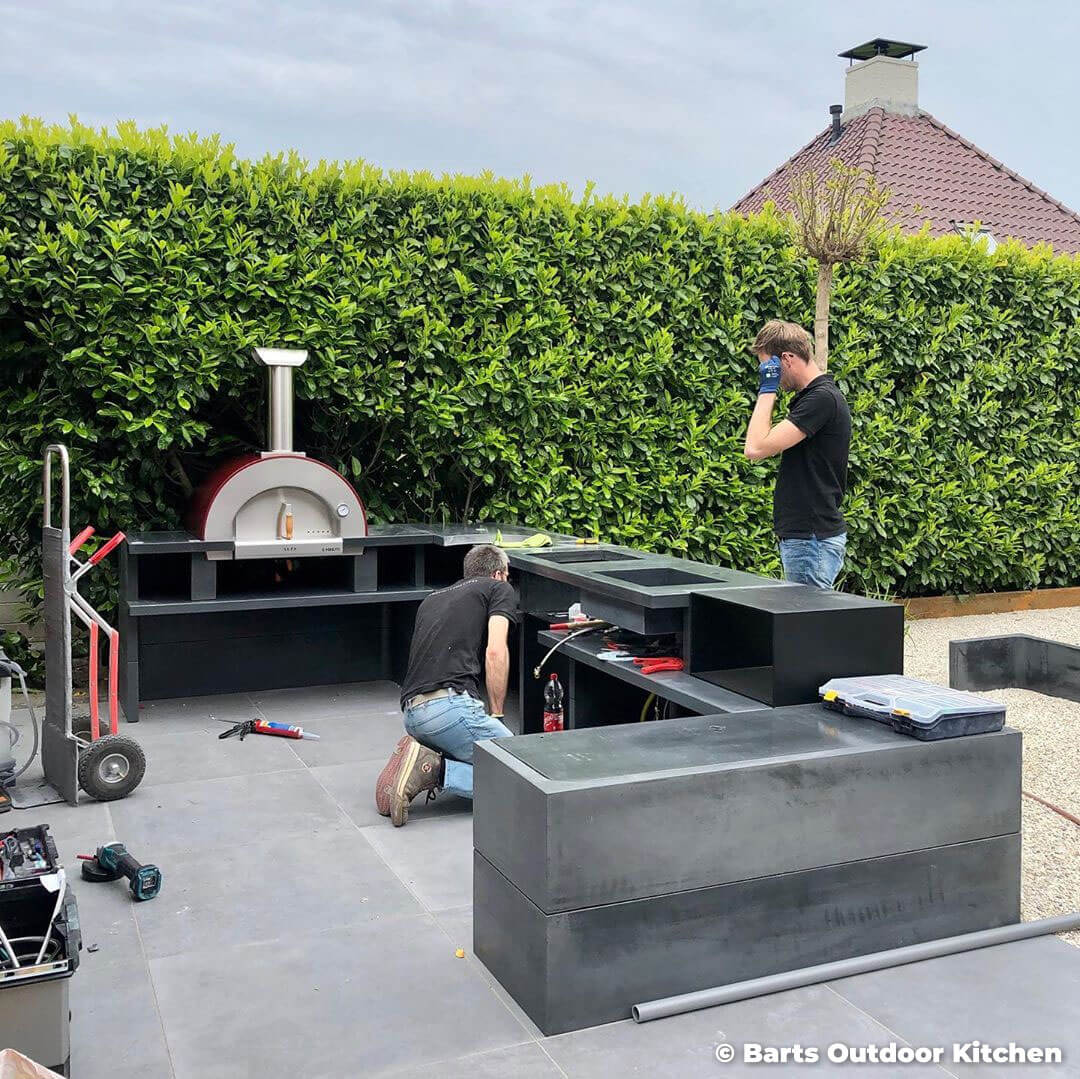Best designing an outdoor kitchen can be quite complex in some cases, due to the many factors involved in the creation of an outdoor environment that meets our needs.
Indeed, every context is different. Not only with regard to the type of home or restaurant activity for which the outdoor kitchen is built, but above all for the choices regarding the different cooking tools needed to prepare foods.
In fact, the cooking tools most characterise the outdoor kitchen, not only because they are the ones that determine which dishes can be made, but also because they contribute to furnishing the environments.
To give an example, you can completely differentiate an outdoor kitchen by choosing between a refractory wood oven, for a rustic and traditional solution, or a steel oven, for a more modern outdoor environment.
Another fundamental choice is how you set up the outdoor kitchen. This depends on the space and budget available and includes deciding whether to create an environment that has fixed or mobile tools (or more often a combination of the two).
In many cases, other factors can influence the design of the outdoor kitchen, for example the creation of a cover to provide shade, also fixed or mobile, choosing for example a gazebo or a pergola.
In this article we offer four important tips for designing a comfortable, functional and carefully designed outdoor kitchen, able to best take advantage of your outdoor environment.
We’ll start with a general discussion to try to order the kitchen design process, defining the limits and opportunities of the various possible options depending on the different contexts.
We will then go into more detail on the four basic recommendations, to which we have already referred to in part. They concern important choices such as the type of environment you want to create, the efficient use of the space available, the type of cooking you want to do and the design you want to give to your outdoor environment.
Our aim is to help people who want to renovate or create their outdoor kitchen but aren’t sure how to choose, given the vast range of options available on the market.
We hope that our advice can help you design a perfect outdoor kitchen for your needs, clarifying the importance of the many factors that are part of an efficient design, tailored to each specific case.
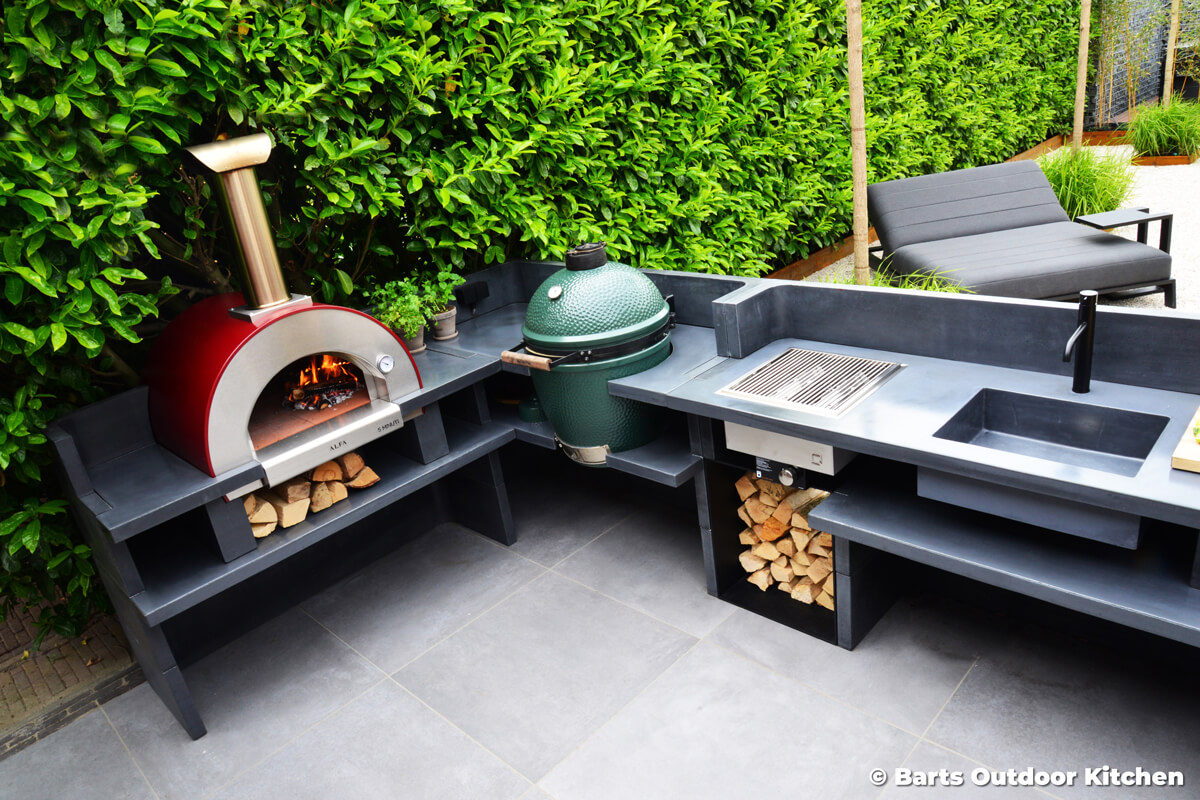
How to design a functional outdoor kitchen
Many factors must be taken into account when designing an efficient outdoor kitchen, since it is precisely an outdoor kitchen’s ability to combine different needs that makes it comfortable and functional.
The design process is of fundamental importance for creating a dynamic outdoor kitchen, making the most of the investment and enriching the outdoor spaces.
At this stage it’s important to first consider any constructive constraints based on the geometry of your outdoor space. Then design the outdoor kitchen based on the location of the water drains, gas pipes and electrical outlets. In doing so, you can already reduce the starting costs, arranging the fixed elements of the kitchen so that less masonry work is necessary.
If taken to the extreme, the least demanding outdoor kitchen solution in terms of construction is the modular one, composed of a sink as a single fixed tool to which one or two mobile cooking tools are added, to be used when necessary.
At the other extreme, we instead have a fixed and complete outdoor kitchen, built like a real extra room and including a strong cover (open only on the sides, perhaps with walls that can be mounted during colder seasons).
One of the main factors characterising an outdoor kitchen is undoubtedly the choice of cooking tools. They define the culinary possibilities of the chef and each of them also comes with different installation constraints.
The cooking tools especially vary according to the different fuel used. Wood is generally preferred outside, due to the lower constraints related to combustion fumes. Gas tools are also quite common for outdoor use, while there is a tendency to avoid electrical tools (unless they are very well covered, for example by choosing recessed models to be placed inside furniture and under a fixed cover).
In addition to the operational aspects, we must also think about the design of the outdoor spaces. This is another very important factor in creating a pleasant environment where you can enjoy lovely days outside.
Cooking tools are a fundamental contribution to furnishing outdoor kitchens. Therefore, you must decide what type of environment you want to create according to your tastes and the needs dictated by the geometries of the outdoor spaces.
For all these reasons, designing an outdoor kitchen is a complex process and there is no ideal solution that applies to everyone. Each person must consider their own needs to create a functional outdoor kitchen, to be able to fully and comfortably take advantage of it. These needs lead us back to the fundamental questions the outdoor kitchen design must start with, namely what you want to cook, how much space you can use and how much you want to spend.
If you keep these fundamental points in mind, it will be possible to create an outdoor kitchen design that perfectly meets the needs of any context, allowing everyone to enjoy a comfortable and functional outdoor environment to cook various recipes.
Let’s now take a look at the four fundamental tips for designing an outdoor kitchen. They concern the fundamental choices we have referred to, namely:
- Choosing the type of environment to create
- Making the most of the available space
- Considering the types of cooking to be carried out
- Choosing the tools to furnish the environments
We will explore each of these below, examining the different needs to consider according to the various contexts in which the outdoor kitchen will be used.
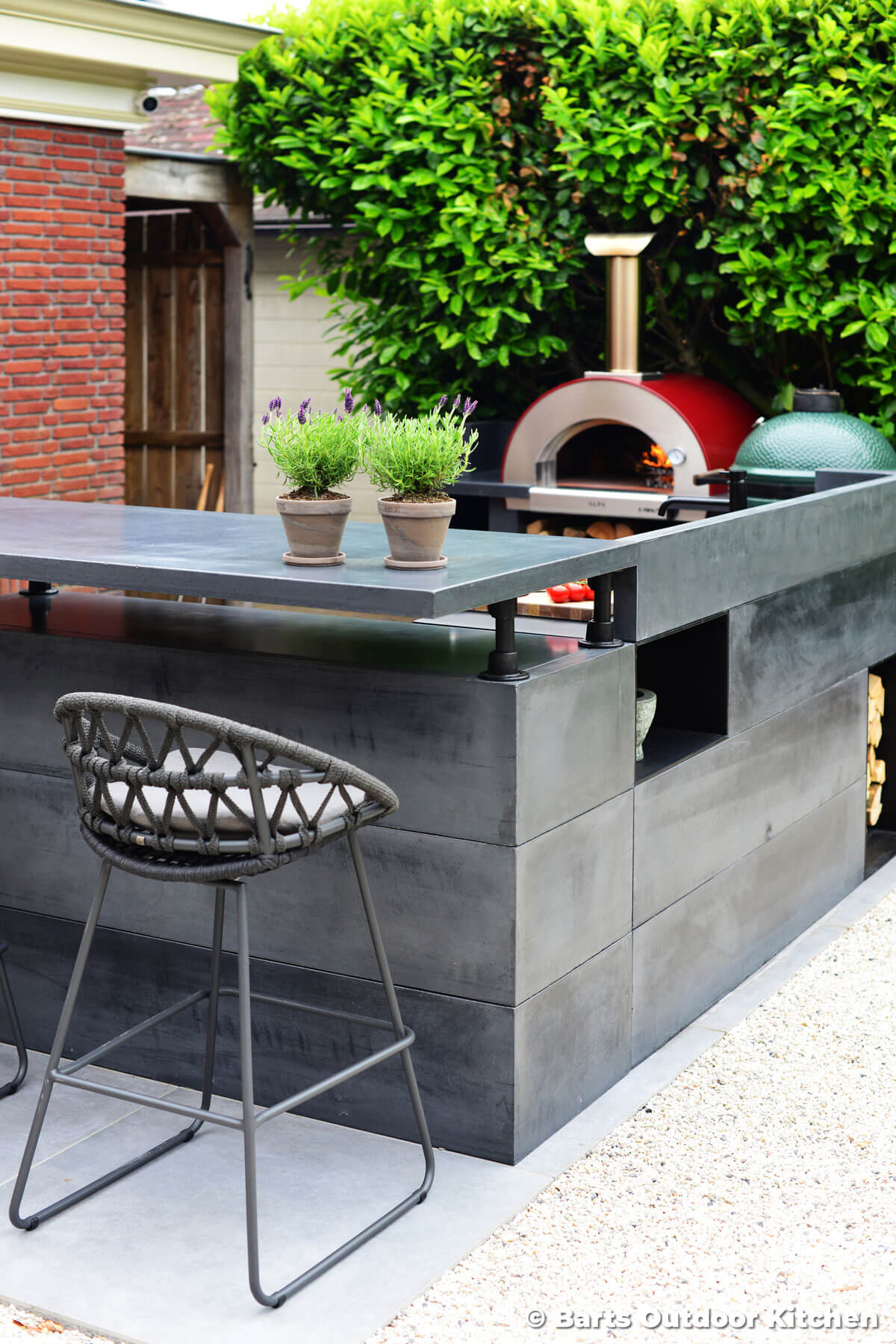
1. Choosing the type of environment to create
The first tip to follow in designing a functional outdoor kitchen is to choose the type of environment you want to create. In fact, you can choose between different solutions starting from the outdoor kitchen setting, as we explained in another article of our blog with five unmissable ideas for your outdoor kitchen.
We saw that the possible solutions can be divided into two categories: fixed or modular kitchens, whose substantial difference lies in the use of fixed or mobile cooking tools.
The second variable involved in this choice relates to the cover which provides shelter from the strong sun during the summer or from evening humidity. Also, in terms of the cover, you can choose between various fixed and mobile solutions.
We can summarise by saying that a modular kitchen with mobile cooking tools is certainly a more versatile solution, since it lets you set up your kitchen differently depending on how you plan to use it. Modular outdoor kitchens are usually less expensive than fixed kitchens due to the decreased amount of work required to build them.
On the other hand, a fixed outdoor kitchen has the great advantage of being more convenient, because you can have everything you need within easy reach. A complete outdoor kitchen certainly requires a greater investment, but it lets you increase the value of your property and make the most of your spaces.
The choice of the outdoor kitchen set up must be the first step in your project, and it must be made considering not only space and budget needs, but above all the operational needs, dictated by how you want to use your outdoor spaces.
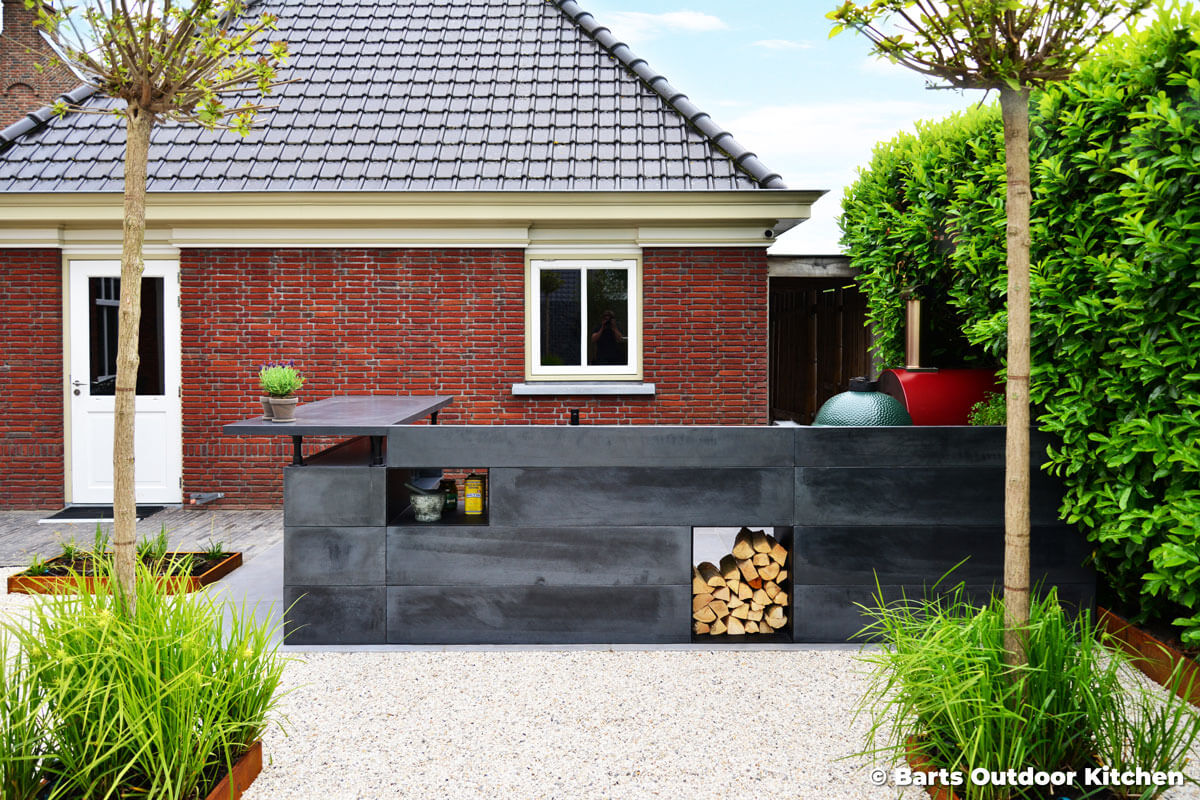
2. Making the most of the available space
The second important tip for designing a comfortable outdoor kitchen is to best take advantage of your outdoor spaces, depending on how you prefer to use them.
Different factors must also be considered with regard to the use of space, which vary according to the case. Obviously, those who have a large terrace or plenty of space in their garden will be free to decide how to use part for their outdoor kitchen, also being able to choose whether to build a fixed outdoor kitchen that includes everything, perhaps even larger than their indoor kitchen.
Those who instead haven’t got very large outdoor spaces usually prefer not to use them permanently with a fixed outdoor kitchen, but to create a modular kitchen with a mobile cooking tool that can be set up only when necessary.
In addition to the amount of space available, you must also consider whether the area will also be used for purposes other than the kitchen. This may be the case of those who use their outdoor space for other activities in summer, for example related to fitness, or in the classic case of a family with children who kick balls around in the garden.
In these cases, if you don’t have plenty of space available, it’s best to create a modular outdoor kitchen, precisely so you have greater freedom of use of your outdoor spaces thanks to mobile cooking tools.
To make the most of the space available, you also have to pay attention to the choice of cooking tools. In addition to the size of the tool, you have to evaluate the space requirements related to its installation.
In the case of wood-burning tools, you also need to prepare a space for stacking the wood and evaluate how to position the tool also based on exposure to wind, which could blow the combustion fumes into guests’ faces.
With regard to gas-powered tools, the problem of fumes is minimal and the same can be said in terms of fuel management. In fact, you can connect gas cooking tools to both the domestic grid (indicated for fixed solutions) and to a tank (ideal for mobile tools).
Summing up, to efficiently take advantage of space in our outdoor kitchen, you need to find a convenient location for the various elements, considering both your operating needs and the installation constraints of the tools.
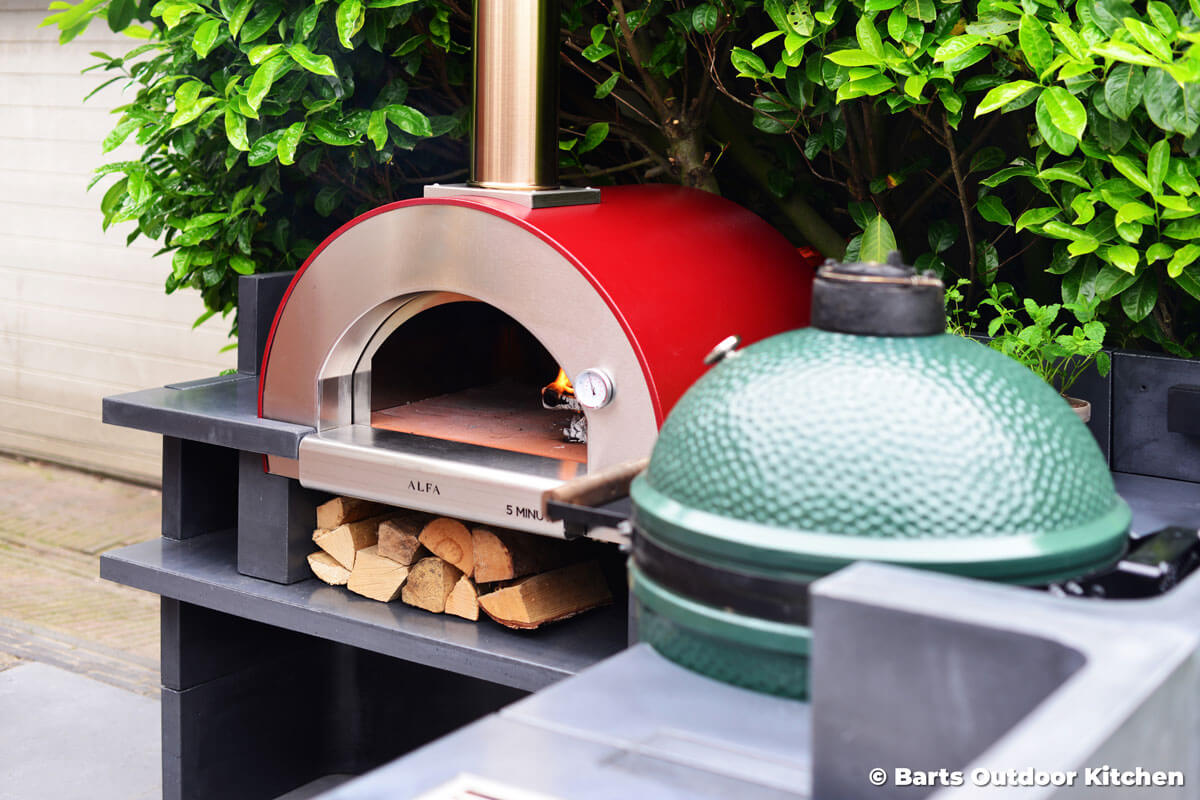
3. Consider the types of cooking to be carried out
As we already mentioned, the third fundamental tip for designing a perfect outdoor kitchen is to clearly consider the dishes you want to cook.
In fact, this dictates the types of cooking tools you’ll install in your outdoor kitchen, focusing the choice on both cooking quality and on optimising your space and budget.
To give an example, you’ll have different needs designing an outdoor kitchen with a traditional fixed wood oven, rather than a modular kitchen equipped with a wood oven with wheels.
Even if you choose tools with the same fuel, the requirements connected to installation constraints, the use of space and the style of the environment you are going to create greatly change.
Those who instead prefer to avoid using wood-burning cooking tools can choose gas tools, perhaps because they live in the city and don’t want the smoke to bother their neighbours or because they have convenient access to gas lines and can easily install a fixed tool outside (saving space and not having to deal with gas tanks).
In these cases, the choice of the type of dishes you want to cook is decisive in choosing cooking tools, for example choosing between a gas barbecue for grilling or an outdoor gas pizza oven.
One tip that we can give for creating a very versatile outdoor kitchen from a culinary point of view is to choose cooking tools that let you cook many different dishes.
One way to do this is to choose hybrid tools, which can work with both wood and gas. This lets you expand the culinary possibilities, as you can experiment with different cooking recipes.
Alfa hybrid oven technology is based on the hybrid kit, which lets you transform a gas oven into a wood oven.
Another way to obtain a versatile kitchen is to equip the kitchen with a main cooking tool and an accessory that expands its possibilities. This is the case, for example, with BBQ500, an accessory for Alfa wood-burning ovens that allows you to comfortably grill food using a wood-burning oven.
BBQ500 lets you saves space and money in your outdoor kitchen project, making it so you don’t have to buy a separate grill or barbecue, as you can grill using your wood oven.
Thinking carefully about what you want to cook is therefore fundamental in designing an outdoor kitchen that meets the needs of each specific case, also considering the space limits and the type of outdoor environment you want to create.
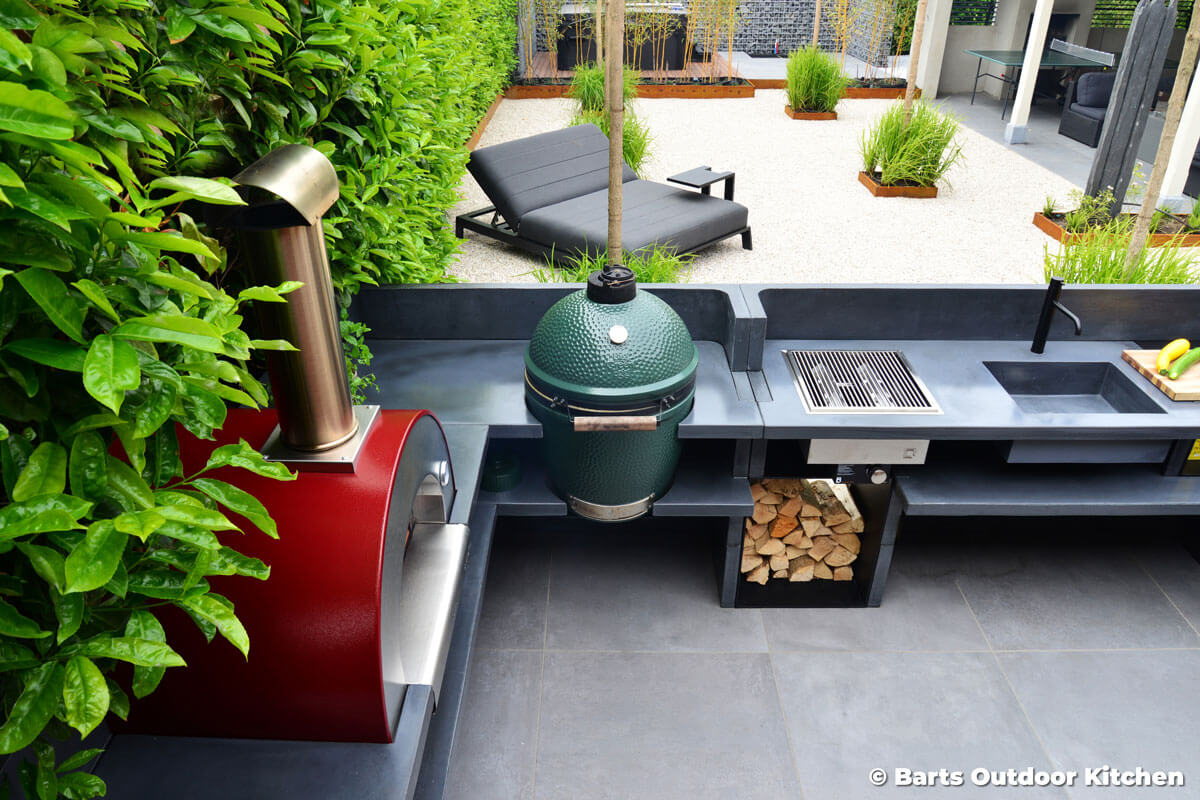
4. Choosing the tools to furnish the environments
Our fourth fundamental tip for creating the perfect outdoor kitchen concerns the design of the outdoor spaces. Outdoor furnishings are a specific branch of designer and architect skills and there are many professionals specialised precisely in this field, whom we recommend relying on for important projects.
Speaking of the aesthetic aspect of your outdoor kitchen, design is not only important because you have to create a pleasant environment, but also to design a functional kitchen, that is, making sure that using the outdoor kitchen is even more comfortable than cooking in the indoor kitchen.
To achieve this, you have to consider the geometry of the available space and your cooking preferences so you can choose the best tools for your case depending on how you want to cook and the style you want the outdoor kitchen to have.
So you have to not only choose the fuel and type of cooking tools, but also the set up you want for your outdoor kitchen (fixed or modular, with or without coverage).
The choice of cooking tools that can furnish the outdoor kitchen can create a comfortable environment with only a few elements, for example choosing an oven with an innovative design, perfect for organising show-cooking evenings
With a good design, even a smaller garden can accommodate a full outdoor kitchen. The only essential elements are a sink as a fixed tool, a table for working and a mobile cooking tool (in addition to a table with chairs for diners, perhaps under a gazebo).
By choosing a cooking tool with a careful design and professional performance, you can create a comfortable environment even with little space and have a comfortable and welcoming outdoor kitchen.
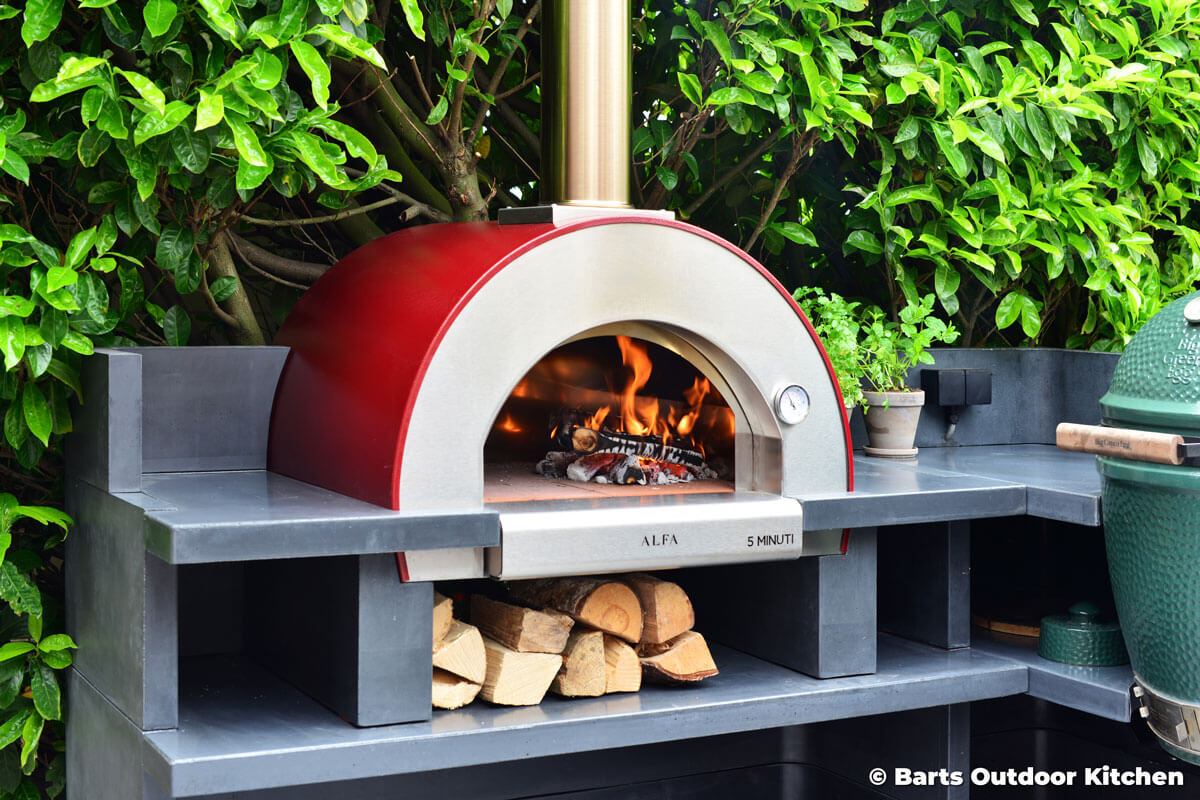
Enhance your outdoor kitchen with an Alfa oven
Summing up, we have seen that the design phase is of fundamental importance for creating a comfortable and functional outdoor kitchen.
The different choices we have discussed are all interconnected, as well as the limits dictated by the installation constraints, the space available and your budget for the outdoor kitchen.
Through these four tips for designing an outdoor kitchen we have provided; we have addressed the importance of the different factors that can guide your choice. They concern the type of kitchen set up (fixed or modular), the availability of space, the type of cooking you mainly want to do and the design you want to give to your outdoor space.
We’ll end this short guide by mentioning the possibilities offered by the range of Alfa outdoor domestic ovens.
In addition to three traditional models of high-quality refractory material, you can choose from eight different models of steel pizza ovens, all available in both fixed and mobile versions. They include four wood-burning ovens, three hybrid ovens (wood and gas) and Nano, the compact oven for those with limited space (available in wood or gas but not in a hybrid version).
All our ovens boast extraordinary quality cooking, a great ease of movement and an extremely careful design, which makes Alfa ovens perfect for furnishing outdoor kitchens, as well as for cooking pizzas like a professional.
We explored the benefits of our ovens in another article of our blog, where we provide five reasons to choose an Alfa oven for your outdoor kitchen.
All that’s left is for us to do is sign off, hoping to have given you useful information for designing the perfect outdoor kitchen for your needs.

